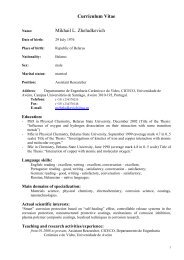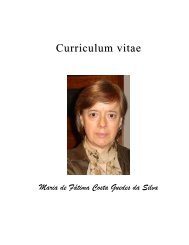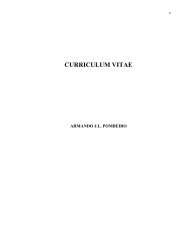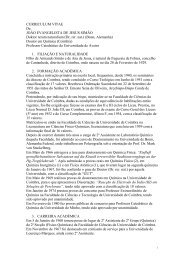XII Iberian Meeting of Electrochemistry XVI Meeting of the ...
XII Iberian Meeting of Electrochemistry XVI Meeting of the ...
XII Iberian Meeting of Electrochemistry XVI Meeting of the ...
Create successful ePaper yourself
Turn your PDF publications into a flip-book with our unique Google optimized e-Paper software.
<strong>XII</strong> <strong>Iberian</strong> <strong>Meeting</strong> <strong>of</strong> <strong>Electrochemistry</strong> & <strong>XVI</strong> <strong>Meeting</strong> <strong>of</strong> <strong>the</strong> Portuguese Electrochemical Society O A 02<br />
Modern QSPR methodology to address non-solved solution<br />
electrochemistry old issues<br />
Luís Moreira, 1,2 Marina Reis, 1 Nelson Nunes, 1,3 Rui Filipe, 3,4 Filomena<br />
Martins, 1,3 Ruben Elvas Leitão 1,3<br />
1 CQB/FCL, Ed. C8, Campo Grande, 1749-016 Lisboa, Portugal<br />
2 ISEC/UCT, Al. das Linhas de Torres, 179, 1750-142 Lisboa, Portugal<br />
3<br />
ISEL/DEQ, R. Conselheiro Emídio Navarro, 1950-062, Lisboa, Portugal<br />
4<br />
CPQ/IST, DEQB, Av. Rovisco Pais, 1049-001 Lisboa, Portugal<br />
lmmoreira@fc.ul.pt<br />
Conductivity measurements <strong>of</strong> 2,6-lutidinium chloride were performed in several<br />
solvents in different concentrations ranging from 0.0001 mol dm -3 to 0.02 mol dm -3 and<br />
temperatures (25.00 to 80.00 ºC). The obtained m = f (c) curves were adjusted to <strong>the</strong><br />
FHP (Fuoss-Hsia-Prini) equation both in its full and truncated forms. The statistical<br />
significance <strong>of</strong> including all three adjustable parameters ( 0 m, K A , a) and fur<strong>the</strong>r terms<br />
used in this equation is fully discussed.<br />
The large amount <strong>of</strong> data collected allowed an in-depth analysis <strong>of</strong> temperature effects<br />
on ionic association and mobility which has been started elsewhere [1]. In particular, <strong>the</strong><br />
application <strong>of</strong> a suitable equation within a QSPR (quantitative structure-property<br />
relationships) context allowed a proper identification and quantification <strong>of</strong> specific ionsolvent-solvent<br />
interactions which play an important role in ionic association. In<br />
addition, <strong>the</strong> temperature dependence <strong>of</strong> <strong>the</strong> referred interactions was also scrutinised.<br />
The present work strongly emphasises <strong>the</strong> need to establish a modern methodology to<br />
address non-solved old issues such as solvent effects on association phenomena in order<br />
to obtain a clearer understanding <strong>of</strong> <strong>the</strong> underlying molecular events.<br />
References<br />
[1] Moreira, L.; Leitão, R. E.; Martins, F. Molecular Physics, 2006, 104, 1905.<br />
September, 811, 2010. ISEL - Lisbon 27








